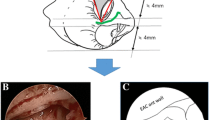Abstract
Multiple theories have been discussed about the etiopathogenesis of congenital middle ear cholesteatoma (CMEC) and its specific site of origin. The intraoperative identification of the precise location of the keratinous mass is important to guarantee its complete removal, in order to reduce the risk of recurrence. This study proposes the tensor tympani tendon (TTT) as a possible site of origin of CMEC. All CMECs treated between 2013 and 2019 were reviewed. Only Potsic stage I lesions were included. Preoperative radiologic images were compared to intraoperative findings. Three removed TTT were sent for histologic evaluation. Seven patients were included (M:F = 3:4). Preoperative CT images were classified as type A in 2 cases (28.6%) and type B in 5 cases (71.4%). At intraoperative evaluation all CMEC sacs were found pedunculated on the TTT. The histologic examinations confirmed the connection between the cholesteatomatous sac and the TTT. According to the correlation of imaging, intraoperative findings and histology, we proposed that the TTT could be the primary site from which CMEC originates.





Similar content being viewed by others
References
Choi HG, Park KH, Park SN, Jun BC, Lee DH, Park YS, et al. Clinical experience of 71 cases of congenital middle ear cholesteatoma. Acta Otolaryngol. 2010;130:62–7.
Levenson MJ, Michaels L, Parisier SC. Congenital cholesteatomas of the middle ear in children: origin and management. Otolaryngol Clin North Am. 1989;22:941–54.
Potsic WP, Samadi DS, Marsh RR, Wetmore RF. A staging system for congenital cholesteatoma. Arch Otolaryngol Head Neck Surg. 2002;128(9):1009–12.
Molteni G, Fabbris C, Molinari G, et al. Correlation between pre-operative CT findings and intra-operative features in pediatric cholesteatoma: a retrospective study on 26 patients. Eur Arch Otorhinolaryngol. 2019;276(9):2449–56.
Lee CH, Kim SY, Kim HM, Kim YJ, Kim JY, Kim MK. Cochleariform Process Abutment on TBCT in Early Congenital Cholesteatoma. Otol Neurotol. 2017;38(1):79–85.
Michaels L. An epidermoid formation in the developing middle ear: possible source of cholesteatoma. J Otolaryngol. 1986;15:169–74.
Cohen D. Locations of primary cholesteatoma. Am J Otol. 1987;8:61–5.
Sadé J, Babiacki A, Pinkus G. The metaplastic and congenital origin of cholesteatoma. Acta Otolaryngol. 1983;96(1–2):119–29.
Ruedi L. Cholesteatoma formation in the middle ear in animal experiments. Acta Otolaryngol. 1959;50(3–4):233–42.
Aimi K. Role of the tympanic ring in the pathogenesis of congenital cholesteatoma. Laryngoscope. 1983;93:1140–6.
Tos M. A new pathogenesis of mesotympanic (congenital) cholesteatoma. Laryngoscope. 2000;110(11):1890–7.
Kashiwamura M, Fukuda S, Chida E, Matsumura M. Locations of congenital cholesteatoma in the middle ear in Japanese patients. Am J Otolaryngol. 2005;26(6):372–6.
Funding
None.
Author information
Authors and Affiliations
Corresponding author
Ethics declarations
Conflicts of interest
The authors declare that they have no conflict of interest.
Ethical Approval
All procedures performed in studies involving human participants were in accordance with the ethical standards of the institutional and/or national research committee and with the 1964 Helsinki declaration and its later amendments or comparable ethical standards. For this kind of retrospective investigation, our institutional review board does not perform a formal ethical assessment. This article does not contain any studies with animals performed by any of the authors.
Informed Consent
Informed consent was obtained from all individual participants included in the study.
Additional information
Publisher's Note
Springer Nature remains neutral with regard to jurisdictional claims in published maps and institutional affiliations.
Rights and permissions
About this article
Cite this article
Maccarrone, F., Molinari, G., Alberici, M.P. et al. The Tensor Tympani Tendon: A Hypothetical Site of Origin of Congenital Cholesteatoma. Head and Neck Pathol 16, 224–228 (2022). https://doi.org/10.1007/s12105-021-01342-4
Received:
Accepted:
Published:
Issue Date:
DOI: https://doi.org/10.1007/s12105-021-01342-4




